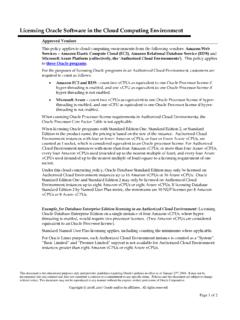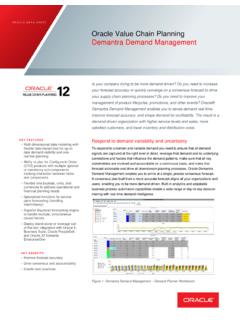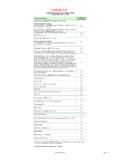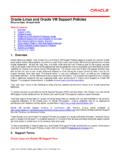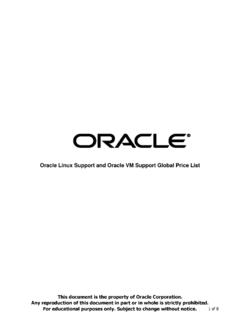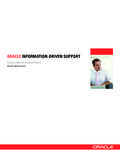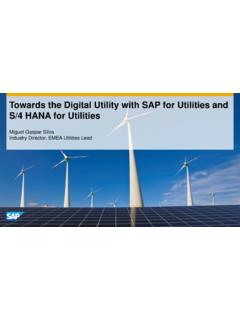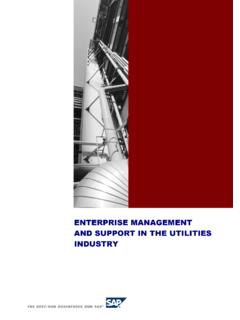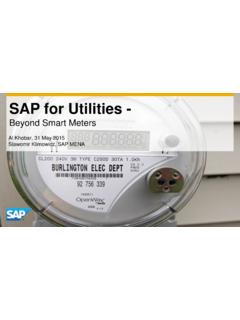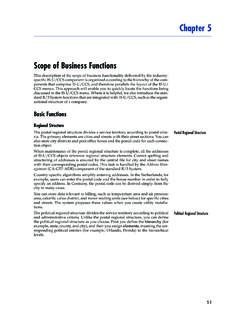Transcription of Advanced Metering Infrastructure Performance - …
1 Advanced Metering Infrastructure Performance TABLE OF CONTENT EXECUTIVE SUMMARY .. 3 RESULTS AT A GLANCE .. 4 DETAILED TEST DESCRIPTION .. 7 Test Scenario Description .. 7 TOUB (EDM-RTP) Scenario .. 7 TOUB (EDM-TOU) Scenario .. 8 TOUB (MDUS-TOU) Scenario .. 9 Upload Activities .. 9 PRODUCT DESCRIPTION .. 10 SAP ..10 Oracle ..10 Fujitsu ..11 Test Environment ..12 RESULTS IN DETAIL .. 13 TOUB (EDM-RTP) Scenario ..13 TOUB (EDM-TOU) Scenario ..15 TOUB (MDUS-TOU) Scenario ..17 Upload Activities ..19 General Findings ..21 BENEFITS OF COMPRESSION .. 23 CONCLUSIONS .. 25 DISCLAIMER .. 26 Advanced Metering Infrastructure Performance 3 EXECUTIVE SUMMARY In many countries, the utilities industry is experiencing massive transformation, not only due to deregulation but also as a result of a shift towards new technologies such as smart Metering .
2 Whilst deregulation results in incumbent utilities companies becoming separate companies covering only parts of the total value chain from power generation through distribution to end-user sales and service, smart Metering has significant impact on the entire value creation chain both in terms of handling business processes and also on data quantity and quality. Whilst a single monthly measurement value was previously sufficient to bill a customer, in future some countries will require 15 or 30 minute interval data to be stored and billed, even for residential customers. SAP and Fujitsu have demonstrated in a stress test how well they can cope with the future data volumes to be handled using SAP s established sap for utilities solution. Running on a Fujitsu PRIMERGY RX600 S5 server, which hosts the Oracle Database 11g Release 2 database system and the SAP instance in a two-tier configuration, up to 30,000,000 daily time series can be uploaded and 1,500,000 business partners billed in under 3 hours.
3 This figure depends on the scenario, of which three have been tested, each of them suitable for a different type of utilities Company according to their market role. Advanced Metering Infrastructure Performance 4 RESULTS AT A GLANCE Three different scenarios for uploading and billing (aggregated) interval metered data in sap for utilities have been tested for Performance in an environment consisting of a Fujitsu PRIMERGY server and an Oracle Database 11g Release 2 database system. This chapter presents a brief summary of the main results. More details can be found in the sections below. Introducing Advanced meters for the residential customer market challenges utilities companies to upload millions of single values into their energy management and billing system and aggregate them for billing.
4 Two different test scenarios have been performed to demonstrate SAP s ability to handle this large volume in a timely manner using moderate hardware. A third tested scenario uploads only aggregated time-of-use blocks from a Meter Data Unification and Synchronization System (MDUS System) and bills them. The first scenario uses the classic EDM for C&I Customers solution for this task. Single values are uploaded and checked for consistency; replacement values are provided for any missing values. Billing uses the Real-Time-Pricing (RTP) interface to calculate four time-of-use (TOU) blocks for billing. Throughout the document this is referred to as TOUB (EDM-RTP) scenario or scenario 1 . The second scenario uses the specially developed time-of-use functionality provided with ECC EhP5 and is intended to speed up processing in cases where the full EDM functionality is not required (for example validation and replacement values) and where billing does not require the functions provided in the RTP interface.
5 In this scenario, values are uploaded to EDM and accepted without modification, billing uses the new time-of-use interface for aggregation and billing residential customers in sap for utilities . In this document it is referred to as the TOUB (EDM-TOU) scenario or scenario 2 . The third scenario uses another recently developed functionality that does not require interval data to be loaded into the sap for utilities System. In this scenario, single interval values remain in the MDUS System, from which the SAP Systems request only aggregated values according to pre-defined time-of-use blocks. Once these TOU blocks are received, billing uses again the new time-of-use interface. TOUB (MDUS-TOU) or scenario 3 are used in this document to refer to this scenario. The reason for the two first tests is to provide figures for a specific scenario, but also to provide a range in which most customer installations will be found.
6 The first very heavy scenario and the second very lean scenario are not usually appropriate here. The third scenario could be an alternative for those customers who do not want to duplicate large amounts of data. Measurements have been performed for different numbers of objects to demonstrate the scalability of the environment. The basic assumption of uploading daily values of N profiles and billing 1/20 of the corresponding installations has been retained. Measurement points were: Total number of business partners (= # of profiles) Number of business partners to be billed daily Number of profile values loaded 20,000 1,000 1,920,000 40,000 2,000 3,840,000 100,000 5,000 9,600,000 200,000 10,000 19,200,000 400,000 20,000 38,400,000 1,000,000 50,000 96,000,000 2,000,000 100,000 192,000,000 4,000,000 200,000 384,000,000 10,000,000 500,000 960,000,000 The series covers everything from a small municipal utility to all but the very largest utility companies.
7 For the last measurement corresponding to profiles (or business partners because in this test the relationship between the two entities is 1:1) the following best results were obtained: Advanced Metering Infrastructure Performance 5 Scenario Total runtime [sec] Total runtime [hh:min] TOUB (EDM-RTP) 7836 2:11 TOUB (EDM-RTP) including 3% replacement values 10341 2:53 TOUB (EDM-TOU) 3358 00:56 TOUB (MDUS-TOU) excluding aggregation in MDUS system 1093 00:18 The following graphs show there is a linear scalability of these times, so if the system only contains a quarter of the number of business partners, the time required to process them is also reduced to 25%. TOUB (EDM-RTP) Scenario Figure 1: Scalability of TOUB (EDM-RTP) scenario steps in terms of installations processed TOUB (EDM-TOU) Scenario Figure 2: Scalability of TOUB (EDM-TOU) scenario steps in terms of installations processed Advanced Metering Infrastructure Performance 6 TOUB (MDUS-TOU) Scenario Figure 3: Scalability of TOUB (MDUS-TOU) scenario steps in terms of installations processed Advanced Metering Infrastructure Performance 7 DETAILED TEST DESCRIPTION The aim of this section is to provide more details about the test for functional and technical experts.
8 Test Scenario Description In this test, three scenarios have been chosen and evaluated. The first one is a scenario based on the Real-Time-Pricing (RTP) interface, which was first shipped with IS-U version in 2005. This scenario provides all the capabilities of SAP s powerful and flexible utilities solution for billing major industrial customers based on time series, but there is a price to pay in terms of Performance . Since RTP is not required in many cases where time-of-use billing is sufficient, a much faster solution based on billing variants has been developed recently; however, it does not provide all functionalities of the RTP interface. All test scenarios are based on 10,000,000 business partners with monthly billing. The (fictitious) utilities company bills its business partners using a round robin method based on 20 working days per month, which gives the company 2-3 non-billing working days to deal with any problems.
9 This means that 500,000 business partners have to be billed every day. To produce the graphs shown in the chapter above, only subsets of the business partners were handled, but the relation between uploaded values and billed business partners was retained. Billing is based on time series of 96 individual values per customer and per day, which corresponds to one measurement every 15 minutes. Single values are aggregated for billing in four time slices according to the following time zones: No differentiation is made between weekdays and weekends. The general assumption is that 3 hours are available each day of the week to upload the daily 10,000,000 time series that each contain 96 values. From Monday through Friday, billing must be performed within these 3 hours. Following billing, additional process steps are necessary before an invoice can be sent to the business partner.
10 These steps are not covered here, since they are part of the SAP utilities benchmark and are the same as those for a traditional Metering scenario. Adding these steps would require approximately three to four additional hours in the same environment depending on the chosen configuration. This means that six to seven hours would be enough for the principal parts of the Metering -to-cash value chain. This time frame corresponds is in line with the requirements of most utilities companies. TOUB (EDM-RTP) Scenario This is the most flexible scenario both in terms of value handling and billing options. During the upload, the (externally known) point-of-delivery (PoD), register code and the internal profile ID are mapped to one another, values are validated and replacement values are generated for any missing values. This is done using a simple procedure: The system compares the last measured value before the interval of missing values and the first measured value after and uses the higher of the two to replace the missing ones.
